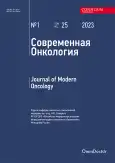The role of minimal residual disease in therapy of pediatric acute lymphoblastic leukemia: a prospective cohort study
- Authors: Korkina Y.S.1, Valiev T.T.1,2
-
Affiliations:
- Russian Medical Academy of Continuous Professional Education
- Blokhin National Medical Research Center of Oncology
- Issue: Vol 25, No 1 (2023)
- Pages: 73-77
- Section: CLINICAL ONCOLOGY
- URL: https://journals.rcsi.science/1815-1434/article/view/132797
- DOI: https://doi.org/10.26442/18151434.2023.1.202154
- ID: 132797
Cite item
Full Text
Abstract
Background. During last 50 years there was a significant progress in understanding the nature of pediatric acute lymphoblastic leukemia (ALL). There were developed effective chemoradiotherapy regimens, new methods of diagnosis and emerged evaluation of treatment results. Determination of minimal residual disease (MRD) has become the most important factor in the patient’s stratification for risk-adapted treatment in the ALL IC-BFM 2009.
Aim. To evaluate the survival rates of children with ALL according to the ALL IC-BFM 2009 protocol.
Materials and methods. There were 136 people in the study of evaluating the effectiveness of therapy according to the ALL IC-BFM 2009 protocol: 69 boys and 67 girls (ratio 1.03:1). The median age is 4 years and 10 months. The observation period is from 26.01.2010 to 06.11.2022.
Results. High survival rates of children with newly diagnosed ALL are achieved: overall survival (OS) is 91.2%, event-free (EFS) – 82.4%, relapse-free (RFS) – 88.6%. The best results are among patients of the standard risk group: OS, EFS and RFS reach 96.6%. In the intermediate group OS – 96.2%, EFS – 84.8% and RFS – 88.3%. Worse results of survival are in the high risk group: OS – 76.9%, EFS – 65.4% and RFS – 80.7%. Outcome analysis depending on the linear reveals a statistically insignificant difference in survival rates (for B-ALL OS – 92.4%, EFS – 83.1% and RFS – 89.5%, for T-ALL OS – 83.3%, EFS – 77.8% and RFS – 83.3%). It determines the tendency of improving the prognosis of pediatric T-ALL by optimizing the stratification of patients based on the indicators of MRD and the best direction of protocol.
Conclusion. Results of survival rates of patients with ALL confirm high effectiveness of treatment according to the ALL IC-BFM 2009 protocol. MRD level on day 15 makes it possible to stratify patients and choose the optimal risk-adapted therapy.
Full Text
##article.viewOnOriginalSite##About the authors
Yulia S. Korkina
Russian Medical Academy of Continuous Professional Education
Author for correspondence.
Email: juliaskomorokhova@mail.ru
ORCID iD: 0000-0002-8482-1863
Graduate Student, Russian Medical Academy of Continuous Professional Education
Russian Federation, MoscowTimur T. Valiev
Russian Medical Academy of Continuous Professional Education; Blokhin National Medical Research Center of Oncology
Email: timurvaliev@mail.ru
ORCID iD: 0000-0002-1469-2365
D. Sci. (Med.), Russian Medical Academy of Continuous Professional Education, Blokhin National Medical Research Center of Oncology
Russian Federation, Moscow; MoscowReferences
- Iacobucci I, Mullighan CG. Genetic Basis of Acute Lymphoblastic Leukemia. J Clin Oncol. 2017;35(9):975-83. doi: 10.1200/JCO.2016.70.7836
- Bhojwani D, Yang JJ, Pui CH. Biology of childhood acute lymphoblastic leukemia. Pediatr Clin North Am. 2015;62(1):47-60. doi: 10.1016/j.pcl.2014.09.004
- Детская онкология. Национальное руководство под ред. М.Д. Алиева, В.Г. Полякова, Г.Л. Менткевича, С.А. Маяковой. М.: Изд. Группа РОНЦ, 2012 [Detskaia onkologiia. Natsionalnoie rukovodstvo pod red. MD Alieva, VG Poliakova, GL Mentkevicha, SA Maiakovoi. Moscow: Izd. Gruppa RONC, 2012 (in Russian)].
- Inaba H, Mullighan CG. Pediatric acute lymphoblastic leukemia. Haematologica. 2020;105(11):2524-39. doi: 10.3324/haematol.2020.247031
- Ольшанская Ю.В., Солдаткина О.И., Никитин Е.Н., и др. Гиподиплоидный кариотип при острых лимфобластных лейкозах из В-линейных предшественников у детей. Вопросы гематологии/онкологии и иммунопатологии в педиатрии. 2021;20(2):97-110 [Olshanskaya YuV, Soldatkina OI, Nikitin EN, et al. A hypodiploid karyotype in childhood B-cell precursor acute lymphoblastic leukemia. Pediatric Hematology/Oncology and Immunopathology. 2021;20(2):97-110 (in Russian)]. doi: 10.24287/1726-1708-2021-20-2-97-110
- Bardelli V, Arniani S, Pierini V, et al. T-Cell Acute Lymphoblastic Leukemia: Biomarkers and Their Clinical Usefulness. Genes (Basel). 2021;12(8):1118. doi: 10.3390/genes12081118
- Raetz EA, Teachey DT. T-cell acute lymphoblastic leukemia. Hematology Am Soc Hematol Educ Program. 2016;2016(1):580-8. doi: 10.1182/asheducation-2016.1.580
- Inaba H, Mullighan CG. Pediatric acute lymphoblastic leukemia. Haematologica. 2020;105(11):2524-39. doi: 10.3324/haematol.2020.247031
- Шервашидзе М.А., Валиев Т.Т. Совершенствование программ терапии острого лимфобластного лейкоза у детей: акцент на минимальную остаточную болезнь. Онкогематология. 2020;15(3):12-26 [Shervashidze MA, Valiev TT. Pediatric acute lymphoblastic leukemia treatment protocols improvement: emphasis on minimal residual disease. Onkogematology. 2020;15(3):12-26 (in Russian)]. doi: 10.17650/1818-8346-2020-15-3-12-26
- Kruse A, Abdel-Azim N, Kim HN, et al. Minimal Residual Disease Detection in Acute Lymphoblastic Leukemia. Int J Mol Sci. 2020;21(3):1054. doi: 10.3390/ijms21031054
- Алескерова Г.А. Лечение детей с острым лимфобластным лейкозом по программе ALL IC-BFM 2002: дис. … канд мед. наук. М., 2018 [Aleskerova GA. Lecheniie detey s ostrym limfoblastnym leykozom po programme ALL IC-BFM 2002: dis. … kand. med. nauk. Мoscow, 2018 (in Russian)].
Supplementary files
















